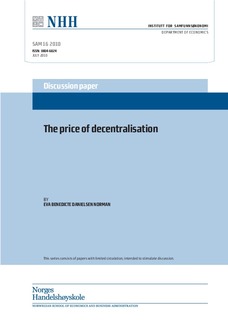| dc.contributor.author | Norman, Eva Benedicte Danielsen | |
| dc.date.accessioned | 2010-10-19T11:34:35Z | |
| dc.date.available | 2010-10-19T11:34:35Z | |
| dc.date.issued | 2010-07 | |
| dc.identifier.issn | 0804-6824 | |
| dc.identifier.uri | http://hdl.handle.net/11250/163232 | |
| dc.description.abstract | This paper develops a model for analysing problems related to
centralisation and decentralisation. The model is of the new economic geography
type, in which there are agglomeration gains in cities but not in rural areas. These
gains are counteracted by residential preferences. We show that, even though people
have preferences for rural living, an unregulated market economy gives too little
centralisation. This result holds even when city governments actively pursue policies
to attract economic activities in order to make their city bigger. When allowing for
cities of unequal size, a likely outcome is that big cities and rural areas will be
overpopulated whereas smaller cities will be too few and too small. | en |
| dc.language.iso | eng | en |
| dc.publisher | Norwegian School of Economics and Business Administration. Department of Economics | en |
| dc.relation.ispartofseries | Discussion paper | en |
| dc.relation.ispartofseries | 2010:16 | en |
| dc.subject | number of cities | en |
| dc.subject | size of cities | en |
| dc.subject | external economies | en |
| dc.subject | local public inputs | en |
| dc.subject | regional competition | en |
| dc.subject | agglomeration | en |
| dc.subject | welfare | en |
| dc.title | The price of decentralisation | en |
| dc.type | Working paper | en |
| dc.subject.nsi | VDP::Samfunnsvitenskap: 200::Urbanisme og fysisk planlegging: 230::Urbanisme: 237 | en |
| dc.subject.nsi | VDP::Samfunnsvitenskap: 200::Økonomi: 210::Samfunnsøkonomi: 212 | en |
